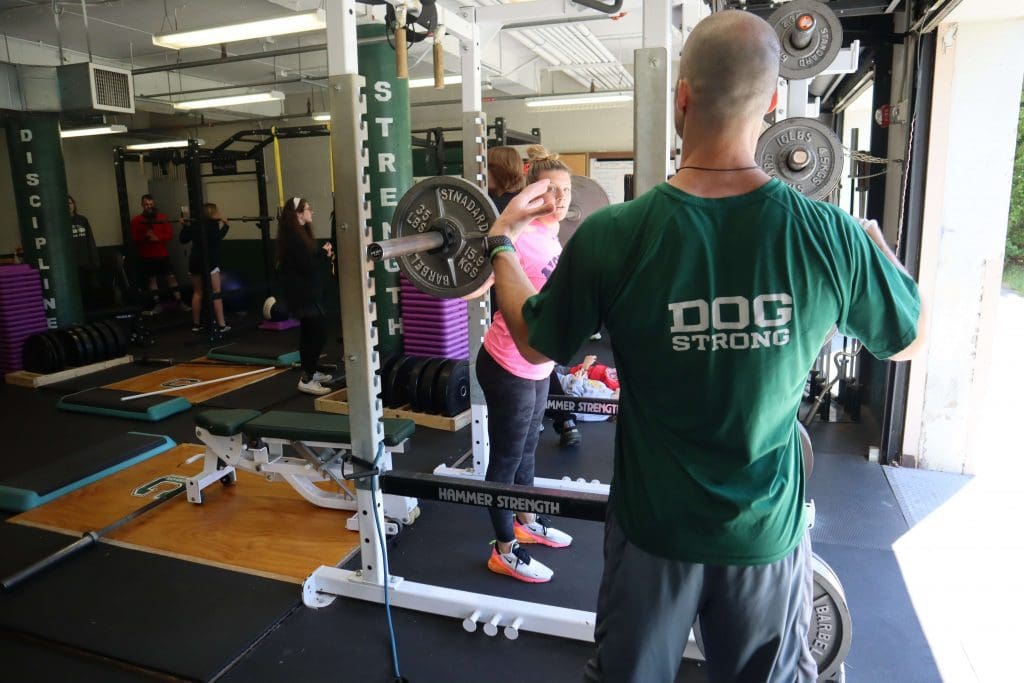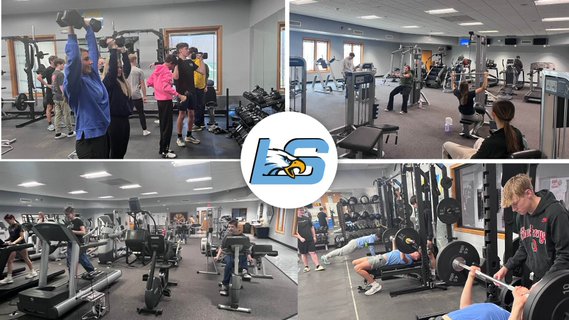Weight room rules for high school students and athletes can create a set of clear expectations and guidelines. In addition, high school weight room rules help create a safe and inclusive environment for everyone to succeed in fitness and strength training. We explore the importance of weight room rules for high school and give 14 real-world examples for your high school weight room. Finally, we provide strategies for teaching and implementing these rules with students. Let’s dive in!
The Importance of Weight Room Rules For High Schools
The high school weight room is becoming one of the most popular rooms in the entire school! Physical education classes use the weight room for everything from an introductory unit on strength training to advanced weight training classes. In addition, sports teams turn to the weight room to improve athletic performance for high school athletes.
Regardless of who and how many students are coming to the weight room throughout the day, it is essential to have a clearly defined set of rules and expectations for high school students.
First and foremost, we want to ensure all students are safe and avoid injury. The weight room is a place to promote health and wellness, not create and cause injury. And that can be achieved through an appropriate introduction to the weight room and the rules.
Secondly, equipment can become dirty, broken, and mismanaged without weight room rules for high school. A clear set of rules will help maintain your equipment and space for many years to come. (We all know getting new equipment is always a big task!)
Finally, the weight room can be an intimidating place for many students. But rules can support more students coming to the weight room with clear expectations for all to work together and not have one team or group dominate the space. For example, others might feel intimidated if the high school football team works out without their shirts on. A simple rule can create a place where everyone knows they are safe and welcome.

Determining and Defining Your Rules
Determining and defining weight room rules for high school environments should be collaborative and transparent.
If you already have a set of rules and expectations, revisit them and ensure they align with your goals and mission. In addition, if your school has a certified strength coach, they likely have a set of weight room rules ready to go. However, strength coaches still often work with the athletic director, sports coaches, and physical education teachers to all be on the same page.
If your school doesn’t have a certified strength coach, you may want to work as a team of coaches, teachers, and other staff members to determine your weight room rules for high school students.
Not sure where to start? Below are 14 different weight room rules for high schools. Some need to be tweaked and adapted based on your school setting, but this is a great place to start when looking for a set of weight room rules! We break these rules by “general” and “strength training specific.” Check them out below!
8 General Weight Room Rules For High School
To start, create a set of general rules that every student should be expected to understand and follow at all times. Consider this a template, and certainly add or subtract to make these weight room rules for high school fit your space and goals to ensure weight room safety for all students!
Adult Supervision – Students and athletes must always be supervised by a coach, teacher, or other adult staff member in the weight room. No exceptions if it is before, during, or after school!
Safe Environment – Everyone is responsible for maintaining a safe and focused environment. No horseplay, pushing, distractions, etc!
Share The Space – All students and athletes are expected to work and share the space as a community. Being a part of a certain team, grade, or group does not give you priority to equipment or space. Work together so that we can all achieve our personal fitness goals.
Tidy Weight Room – Return equipment to appropriate places after use. Keep the floors and walkways clear to keep everyone safe when moving throughout the weight room.
Clean Equipment – Wipe down equipment or spaces after use, even if you don’t think you left it “that sweaty.”
No Food or Drink – Leave all food and drink outside of the weight room. Water bottles are allowed inside the weight room.
Appropriate Music – If playing music in the weight room, follow all school rules around language and music choice.
Wear Proper Workout Attire – (Each school should determine what they consider appropriate attire. Some schools will make clear rules about types of shoes while others will make recommendations but not prohibit students from the weight room if they don’t have the right shoes.)

6 Strength Training Specific Weight Room Rules For High School
Beyond general rules, students should also understand the basics of proper lifting techniques and safety protocols. But please note these rules should be tailored to your equipment and space! These strength training-specific rules include:
Lifting Safely – All students should perform movements with proper technique and appropriate weights. If proper lifting techniques become unmanageable because the weights are too heavy, talk to a teacher or coach to determine what you should do next.
Don’t Drop Metal Weights, Empty Barbells, or Dumbbells – Dropping this type of equipment can cause damage and may cause harm to those around you. Place weights down with control.
Bumper Plate Protocol – Bumper plates can be dropped only on platforms or rubber floors WITH CONTROL. Ensure you have space to drop weights safely, and always ask a teacher or coach if you need clarification on dropping bumper plates.
Loading & Unloading The Barbell – Do so carefully and evenly when loading and unloading free weights onto the barbell. As you add more weights to the bar, it can become unsafe to take all free weights off of one side before the other.
Collars, Clips, & Pins – Properly secure the barbell with collars or clips when lifting with free weights. When using machines, fully insert any safety pins necessary.
Preparing For Failure – Depending on the lift or exercise, determine the proper plan for failure. For example: 1. Have a spotter when you bench press. 2. Use support bars when back squatting. 3. Use bumper plates when power cleaning. Review all procedures for different lifts. Weight room rules for high school strength training may vary here.
Bonus Content! This introductory video outlines how to set up for a barbell back squat, perform the movement, and safely fail the lift if necessary.
Implementing and Introducing Rules To Students
Once you have determined your set of high school weight room rules, you must introduce and implement them to students.
First, take your rules and display them where they are clearly visible to students in the high school weight room, locker room, or other places.
Next, don’t just expect your students to read and understand the rules. Many schools have students read and sign a copy of the weight room rules before being allowed to participate in a workout program via athletics or physical education.
Finally, consider the role of an introductory weight training program to help students understand weight room rules for high school and beyond. Not only can you teach students proper etiquette and best practices, they will also learn proper techniques in the process.
By introducing students to the basics of weight training, you can reinforce your weight room rules and set students up for long-term success. This can be done via physical education classes, and every single student at the school can learn the basics of weight training and weight room rules.

Key Takeaways On Weight Room Rules For High School
Weight room rules for high schools are a valuable tool for making the high school weight room a safe and enjoyable place for all students and staff members. Defining and sticking to a standard set of rules can create a cohesive approach to the weight training program at your school. In addition, all staff members (teachers, coaches, athletic trainers, athletic directors, and more) can work together with a set of consistent and clear rules.
Some other key takeaways are:
Keep safety a top priority!
Have a consistent set of rules across all groups.
An introduction to weight training and weight room can help all students learn proper technique and the rules. Don’t just expect students to know the rules!







